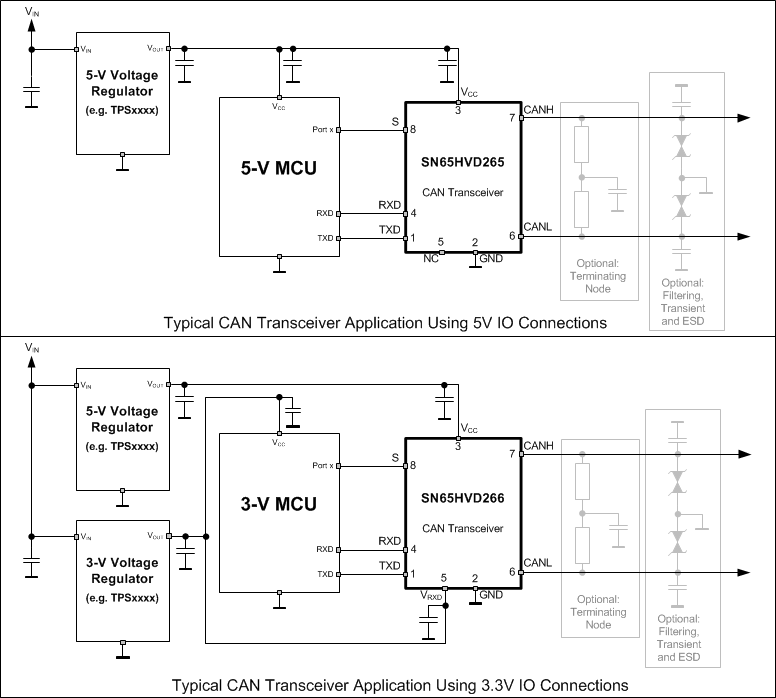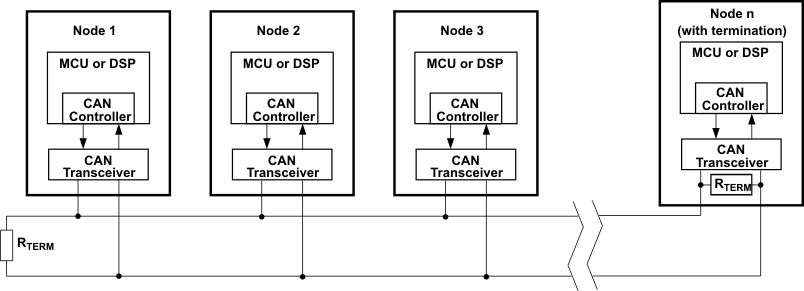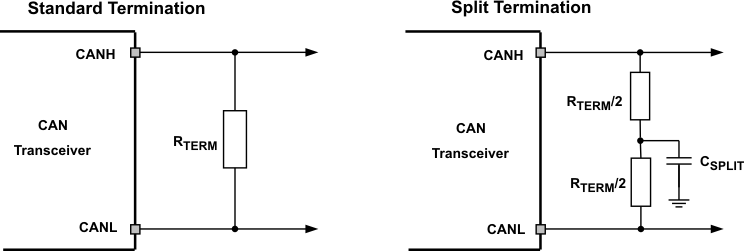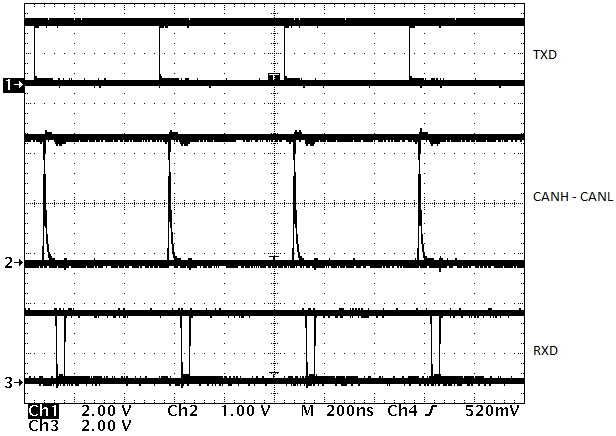SLLSEI3A September 2013 – November 2015 SN65HVD265 , SN65HVD266 , SN65HVD267
PRODUCTION DATA.
- 1 Features
- 2 Applications
- 3 Description
- 4 Revision History
- 5 Device Comparison Table
- 6 Pin Configurations and Functions
- 7 Specifications
- 8 Parameter Measurement Information
- 9 Detailed Description
- 10Application and Implementation
- 11Power Supply Recommendations
- 12Layout
- 13Device and Documentation Support
- 14Mechanical, Packaging, and Orderable Information
Package Options
Mechanical Data (Package|Pins)
- D|8
Thermal pad, mechanical data (Package|Pins)
Orderable Information
10 Application and Implementation
NOTE
Information in the following applications sections is not part of the TI component specification, and TI does not warrant its accuracy or completeness. TI’s customers are responsible for determining suitability of components for their purposes. Customers should validate and test their design implementation to confirm system functionality.
10.1 Application Information
These CAN transceivers are typically used in applications with a host microprocessor or FPGA that includes the link layer portion of the CAN protocol. Below are typical application configurations for both 5 V and 3.3 V microprocessor applications. The bus termination is shown for illustrative purposes.
10.2 Typical Application
 Figure 16. Typical 5-V Application
Figure 16. Typical 5-V Application
10.2.1 Design Requirements
10.2.1.1 Bus Loading, Length and Number of Nodes
The ISO11898 Standard specifies a maximum bus length of 40m and maximum stub length of 0.3m. However, with careful design, users can have longer cables, longer stub lengths, and many more nodes to a bus. A large number of nodes requires a transceiver with high input impedance such as the SN65HVD26x family.
Many CAN organizations and standards have scaled the use of CAN for applications outside the original ISO11898. They have made system level trade offs for data rate, cable length, and parasitic loading of the bus. Examples of some of these specifications are ARINC825, CANopen, DeviceNet and NMEA2000.
A CAN network design is a series of tradeoffs, but these devices operate over wide common-mode range. In ISO11898-2 the driver differential output is specified with a 60Ω load (the two 120Ω termination resistors in parallel) and the differential output must be greater than 1.5V. The SN65HVD26x family is specified to meet the 1.5V requirement with a 45Ω load incorporating the worst case including parallel transceivers. The differential input resistance of the SN65HVD26x is a minimum of 30KΩ. If 167 SN65HVD26x family transceivers are in parallel on a bus, this is equivalent to a 180Ω differential load worst case. That transceiver load of 180Ω in parallel with the 60Ω gives a total 45Ω. Therefore, the SN65HVD26x family theoretically supports over 167 transceivers on a single bus segment with margin to the 1.2V minimum differential input at each node. However for CAN network design margin must be given for signal loss across the system and cabling, parasitic loadings, network imbalances, ground offsets and signal integrity thus a practical maximum number of nodes is typically much lower. Bus length may also be extended beyond the original ISO11898 standard of 40m by careful system design and datarate tradeoffs. For example CANopen network design guidelines allow the network to be up to 1km with changes in the termination resistance, cabling, less than 64 nodes and significantly lowered data rate.
This flexibility in CAN network design is one of the key strengths of the various extensions and additional standards that have been built on the original ISO11898 CAN standard. In using this flexibility comes the responsibility of good network design and balancing these tradeoffs.
10.2.2 Detailed Design Procedures
10.2.2.1 CAN Termination
The ISO11898 standard specifies the interconnect to be a twisted pair cable (shielded or unshielded) with 120 Ω characteristic impedance (ZO). Resistors equal to the characteristic impedance of the line should be used to terminate both ends of the cable to prevent signal reflections. Unterminated drop lines (stubs) connecting nodes to the bus should be kept as short as possible to minimize signal reflections. The termination may be on the cable or in a node, but if nodes may be removed from the bus the termination must be carefully placed so that it is not removed from the bus.
 Figure 17. Typical CAN Bus
Figure 17. Typical CAN Bus
Termination may be a single 120 Ω resistor at the end of the bus, either on the cable or in a terminating node. If filtering and stabilization of the common mode voltage of the bus is desired, then split termination may be used. (See Figure 18). Split termination improves the electromagnetic emissions behavior of the network by eliminating fluctuations in the bus common-mode voltages at the start and end of message transmissions.
 Figure 18. CAN Bus Termination Concepts
Figure 18. CAN Bus Termination Concepts
10.2.2.2 Functional Safety Using the SN65HVD267 in a Redundant Physical Layer CAN Network Topology
CAN is a standard linear bus topology using 120 Ω twisted pair cabling. The SN65HVD267 CAN device includes several features to use the CAN physical layer in nonstandard topologies with only one CAN link layer controller (μP) interface. This allows much greater flexibility in the physical topology of the bus while reducing the digital controller and software costs. The combination of RXD DTO and the FAULT output allows great flexibility, control and monitoring of these applications.
A simple example of this flexibility is to use two SN65HVD267 devices in parallel with an AND gate to achieve redundancy (parallel) of the physical layer (cabling and PHYs) in a CAN network.
For the CAN bit-wise arbitration to work, the RXD outputs of the transceivers must connect via AND gate logic so that a dominant bit (low) from any of the branches is received by the link layer logic (μP), and appears to the link layer and above as a single physical network. The RXD DTO feature prevents a bus stuck dominant fault in a single branch from taking down the entire network by forcing the RXD terminal for the transceivers on the branch with the fault back to the recessive after the tRXD_DTO time. The remaining branch of the network continues to function. The FAULT terminal of the transceivers on the branch with the fault indicates this via the FAULT output to their host processors, which diagnose the failure condition. Adding a logic XOR with a filter adds automatic detection for a fault where one of the 2 networks goes open (recessive) in addition to the faults detected by the SN65HVD267. The S terminal (silent mode terminal) may be used to put a branch in silent mode to check each branch for other faults. Thus it is possible to implement a robust and redundant CAN network topology in a simple and low cost manner.
These concepts can be expanded into more complicated and flexible CAN network topologies to solve various system level challenges with a networked infrastructure.

10.2.3 Application Curve
